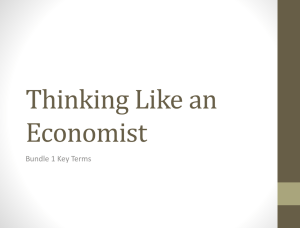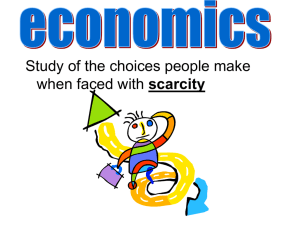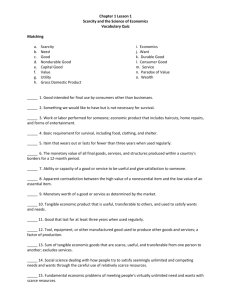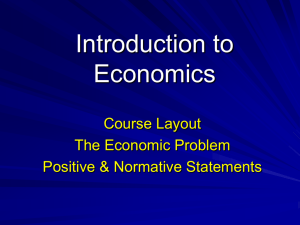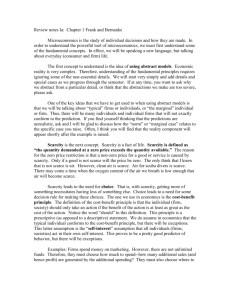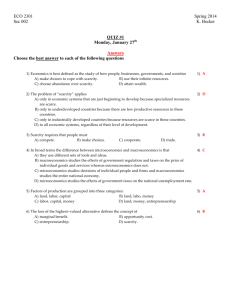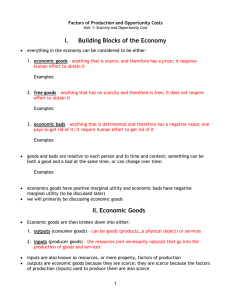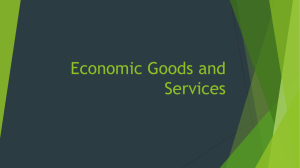Microeconomics Introduction 1.1 Microeconomics: The Allocation of
advertisement
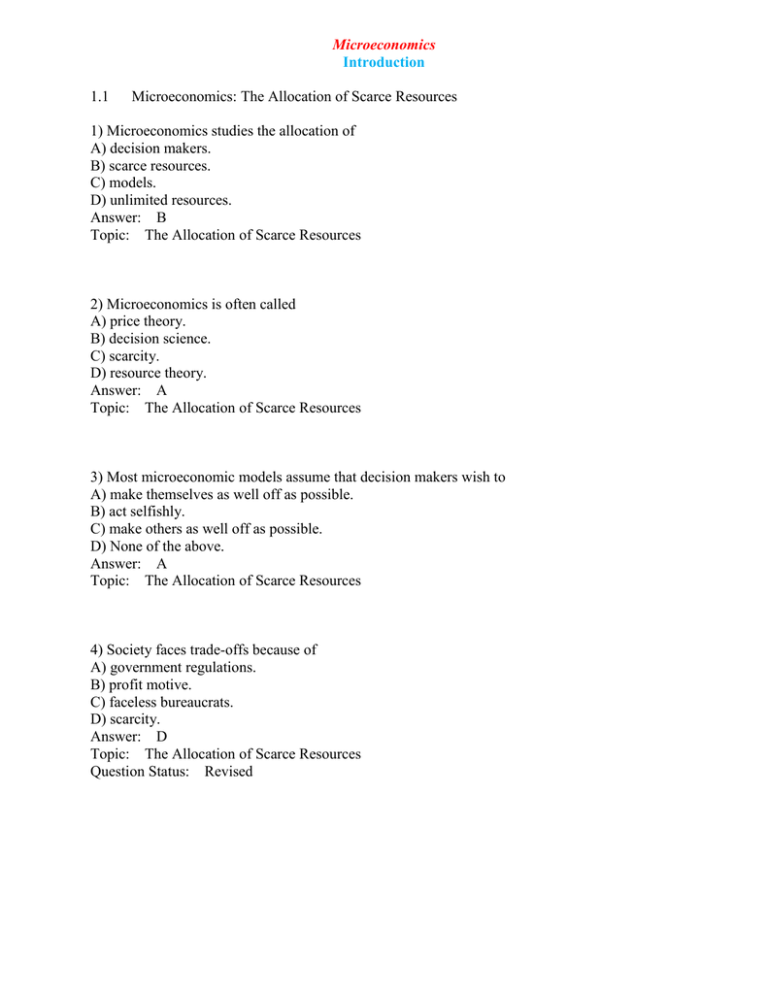
Microeconomics Introduction 1.1 Microeconomics: The Allocation of Scarce Resources 1) Microeconomics studies the allocation of A) decision makers. B) scarce resources. C) models. D) unlimited resources. Answer: B Topic: The Allocation of Scarce Resources 2) Microeconomics is often called A) price theory. B) decision science. C) scarcity. D) resource theory. Answer: A Topic: The Allocation of Scarce Resources 3) Most microeconomic models assume that decision makers wish to A) make themselves as well off as possible. B) act selfishly. C) make others as well off as possible. D) None of the above. Answer: A Topic: The Allocation of Scarce Resources 4) Society faces trade-offs because of A) government regulations. B) profit motive. C) faceless bureaucrats. D) scarcity. Answer: D Topic: The Allocation of Scarce Resources Question Status: Revised 5) A market A) always involves the personal exchange of goods for money. B) allows interactions between consumers and firms. C) always takes place at a physical location. D) has no influence on prices. Answer: B Topic: The Allocation of Scarce Resources 6) What links the decisions of consumers and firms in a market? A) the government B) prices C) coordination officials D) microeconomics Answer: B Topic: The Allocation of Scarce Resources 7) The price of a good is A) always equal to the cost of producing the good. B) never affected by the number of buyers and sellers. C) usually determined in a market. D) None of the above. Answer: C Topic: The Allocation of Scarce Resources 8) The flu vaccination example in Section 1.1 is an example of how policy makers may cope with A) scarcity of medical treatment. B) scarcity of patients. C) scarcity of policy makers. D) answering the question of how to produce. Answer: A Topic: The Allocation of Scarce Resources 9) Who or what is responsible for applying scarce resources to the production of most goods in the U.S.? A) the U.S. government B) the United Nations C) the Federal Reserve Bank D) markets and prices Answer: D Topic: The Allocation of Scarce Resources 10) Which of the following is a fundamental question addressed by microeconomics? A) Whether to provide a social safety net. B) Which goods to produce. C) The level of unemployment in the country. D) Whether to send a manned expedition to Mars. Answer: B Topic: The Allocation of Scarce Resources 11) A "twinkie tax" on fatty foods would aim to A) reduce the consumption of fatty foods. B) reduce the production of fatty foods. C) raise tax revenues for other uses. D) All of the above. Answer: D Topic: The Allocation of Scarce Resources For the following, please answer "True" or "False" and explain why. 12) Under most circumstances, the application of taxes on goods will only affect who gets the goods. Answer: False. Taxes will affect which goods are produced, how goods are produced, and who gets the goods. Topic: The Allocation of Scarce Resources 13) Most modern financial centers use computers to match buyers and sellers. This absence of personal contact contradicts the definition of a market. Answer: False. Buyers and sellers need not meet during a market transaction since a market is not tied to a particular location. Topic: The Allocation of Scarce Resources 14) Governments do not respond to prices. Answer: False. When products or services that governments purchase become more expensive, governments tend to purchase less of the products. For example, when the price of gasoline increased dramatically in the Spring of 2006, the state of Georgia restricted the use of school buses. Topic: The Allocation of Scarce Resources 15) Explain how a market helps determine which goods and services will be produced, how to produce them, and who gets them. Answer: A market promotes interaction between consumers and firms. This interaction will result in prices, which influence the decisions of consumers and firms. Topic: The Allocation of Scarce Resources 1.2 Models 1) The purpose of making assumptions in economic model building is to A) force the model to yield the correct answer. B) minimize the amount of work an economist must do. C) simplify the model while keeping important details. D) express the relationship mathematically. Answer: C Topic: Models 2) Einstein was quoted saying "Everything should be made as simple as possible, but not simpler." When it comes to economic models this means that A) models shouldn't be too complex. B) models shouldn't be too simple. C) models should have a level of abstraction appropriate to the topic investigated. D) all of the above Answer: D Topic: Models 3) If a model's predictions are correct, then A) its assumptions must have been correct. B) it is proven to be correct. C) Both A and B above. D) None of the above. Answer: D Topic: Models 4) Economists tend to judge a model based upon A) the reality of its assumptions. B) the accuracy of its predictions. C) its simplicity. D) its complexity. Answer: B Topic: Models 5) Which of the following is an example of a normative statement? A) A higher price for a good causes people to want to buy less of that good. B) A lower price for a good causes people to want to buy more of that good. C) To make the good available to more people, a lower price should be set. D) If you consume this good, you will be better off. Answer: C Topic: Models 6) Every economic model should include money as a variable. This statement is A) true, because every transaction in the economy uses money. B) true, because the federal reserve is very important. C) false, because some transactions in the economy are accomplished without money. D) false, because a model can get unnecessarily complex if it includes money. Answer: D Topic: Models Question Status: Revised 7) Which of the following is an example of a normative statement? A) Since this good is bad for you, you should not consume it. B) This good has bad health effects. C) If you consume this good, you will get sick. D) People usually get sick after consuming this good. Answer: A Topic: Models 8) Which of the following is an example of a positive statement? A) Since this good is bad for you, you should not consume it. B) If this good is bad for you, you should not consume it. C) If you consume this good, you will get sick. D) None of the above. Answer: C Topic: Models 9) If an important assumption is omitted from an economic model A) the model's predictions will be accurate 50% of the time. B) the model's predictions will be inaccurate. C) the model will not predict anything. D) the model will be rejected by other economists. Answer: B Topic: Models 10) Economic models are most useful in A) predicting changes in one variable due to a change in one or more other variables. B) predicting the direction of the stock market. C) explaining the future with the past. D) generating untestable hypotheses. Answer: A Topic: Models 11) Economic modeling requires A) mathematics. B) logic. C) calculus. D) trigonometry. Answer: B Topic: Models 12) Economic models are most often tested A) using computer simulations. B) using data from the distant past. C) using data from the real world. D) using logic alone. Answer: C Topic: Models 13) Which of the following is not considered an ingredient to an economic model? A) Assumptions B) Logic C) Hypotheses D) Experience Answer: D Topic: Models 14) 2 + 2 = 5 is A) a normative statement. B) a moral judgment. C) correct, given common assumptions. D) a positive statement. Answer: D Topic: Models For the following, please answer "True" or "False" and explain why. 15) Normative analysis offers decision makers the most valuable information when choosing among alternatives. Answer: False. Normative analysis states subjective goals but not how those goals can be achieved. To choose among alternatives decision maker uses positive analysis. Topic: Models 16) If a model fits reality but doesn't generate testable predictions, it is of little value to economists. Answer: True. If the model doesn't deliver testable predictions it cannot be tested against competing models. Topic: Models 17) If actual experience supports two competing theories, then both theories are proven to be true. Answer: False. Neither theory can be rejected but if they are competing, then the test is inconclusive. Topic: Models 18) Normative statements are easily debated whereas positive statements are simply rhetorical. Answer: False. Positive statements are not merely rhetorical. Rather, positive statements are testable statements. On the other hand, normative statements are not testable and therefore are often the most debated topics in society. Topic: Models 19) Legislators argue that a minimum wage law is instituted to help poor people. Economists can attack the minimum wage law on two fronts. First, some argue that government should not help the poor. Second, some argue that minimum wage laws actually hurt the poor because it creates unemployment. Which argument is normative and which is positive? Answer: An opinion about the role of government is a normative statement. An observation about the impact of a law is a positive statement. Topic: Models 1.3 Uses of Microeconomic Models 1) Economic Policy of the government is often based on A) microeconomic models. B) educated guessing. C) intuitive reasoning. D) hints. Answer: A 2) Microeconomic Models are used to A) make predictions. B) explain real-life phenomena. C) evaluate policy alternatives. D) All of the above. Answer: D 3) A microeconomic model CANNOT be used to A) evaluate the impact of a price change on a firm's revenue. B) predict the impact of an increase in the minimum wage on unemployment. C) evaluate the fairness of a proposal to nationalize health insurance. D) evaluate the effect of an increase in stadium size on the price of a sport team's tickets. Answer: C Question Status: Revised 4) Which philosophical statement is incompatible with economic modeling? A) Assume nothing. B) The early bird gets the worm. C) One must break some eggs to make an omelette. D) You cannot have your cake, and eat it too. Answer: A 5) The testing of economic models facilitates A) proving a model is false. B) proving a model is true. C) proving that one person's opinion is morally incorrect. D) proving that one society's legal structure is better than another country's. Answer: A 6) Economic models are only useful in analyzing government policy. A) True, individuals are irrational and therefore economic models are useless. B) False, economic models can be used to predict individual and firm behavior. C) True, economists only model those questions for which they are hired. D) False, economic models are not even useful in analyzing government policy. Answer: B 7) Economic models are only applicable to free-market countries. A) False. Economic models are applicable wherever there is scarcity. B) True. Economic models are applicable only when private citizens are free to make their own decisions. C) False. Economic models are applicable in all countries with more than one million people, regardless of political structure. D) True. Economic models are only applicable when government is small relative to the rest of the economy. Answer: A For the following, please answer "True" or "False" and explain why. 8) Microeconomics can be used by governments to predict the impacts of a policy and suggest solutions to problems. Answer: True. Microeconomics models can be used to examine the effects of a policy, and can provide insight into possible solutions to economic problems. 9) One million automobiles have a defect that could cause the car to explode; however, only one of those cars will actually explode. Nobody knows which one car it is. When the car does explode, the victim's family will sue the automaker for $1 million and win. The defect costs $2 per car to repair. What does economics predict about the automaker's decision to repair the defect? Answer: Correcting the defect will cost $2 million. Not correcting the defect will only cost $1 million. Economics predicts that the automaker will not correct the defect. 10) Describe in words the anatomy of an economic model. Answer: An economic model is comprised of a set of assumptions that lead to a set of implications. In an effective economic model, if one or more of the assumptions are changed, so too is the set of implications. In other words, any assumption that does not influence the implications is superfluous and can be dropped from the model. In an effective economic model, the implications are clearly stated and testable using real-world data.
